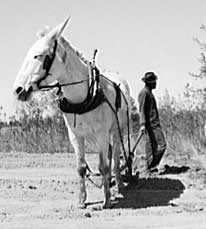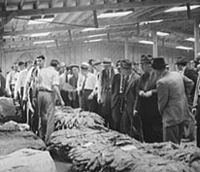North
Carolina
Business
History
Settled as a maritime and agricultural colony, North Carolina developed its businesses slowly in the colonial period. Relatively isolated rural farms prior to the Civil War struggled to grow family food supplies. So surplus, cash crops were few.




During colonial periods, the British discouraged cotton production in America to protect its woolen and linen manufacturers. But tobacco was the most important commercial crop in colonial North Carolina.
Tobacco at this period was primarily a Virginia and Maryland crop (ranked 1 and 2), followed by with a few North Carolina (ranked 3rd) counties near Albemarle Sound also producing tobacco.
Pork production had an early start in North Carolina. As one visitor wrote in 1783: "Nowhere on the whole continent is the breeding of swine so considerable or so profitable as in North Carolina." There also was a effort for cattle production during the early years. By the mid-1770s, it was estimated that 30,000 cattle and 30 to 50 thousand hogs were being driven overland annually to markets in Norfolk, Baltimore, Philadelphia and New York.
A New Country
Agriculture and farming remains the leading industry through today. Although cotton and tobacco farming have been larger in the past, the state also has become a leader in pork and poultry production.
The leading crops over the years were cotton and tobacco.
Post Civil War
Agriculture remained the basic occupation for the North Carolina population following the war. By 1860, there were more than 75,000 farms in the state with two-thirds under 100 acres. Despite an agricultural depression in prices following the Civil War up to 1900, the number of North Carolina farms steadily increased.
By 1900, there were 224,637 farms and in 1925 there were 283,482 North Carolina farms.
The cotton crop remained static between 1860 with 145,514 bales and 1870 with 144,935 bales. But other crops declined. For example, tobacco dropped from 32.9 million pounds in 1860 to 11.2 million pounds in 1870. Other crops showed similar declines, such as wheat, oats, corn, rice, sweet potatoes.
But most crops staged a comeback in production volume between 1870 and 1900. There were exceptions — rice and wheat didn't reach their pre-war levels. An increasingly, the cash crops were cotton and tobacco.
By 1900, North Carolina was producing 433,000 bales, which accelerated in the early 1900s to match the explosive growth of the textile industry. By 1925, North Carolina was producing 1,102,000 bales of cotton.
Tobacco production also regained its volume after the Civil War. In 1860, North Carolina produced 33 million pounds, but only 11 million pounds in 1870. By 1890, the state was producing 36 million pounds of tobacco and its new mechanized tobacco manufacturing (in the 1880s and 1890s) poised dramatic future growth.
In 1900, North Carolina produced 127.5 million pounds of tobacco which grew to 380.2 million pounds in 1925. In 1920, Winston-Salem and Durham factories produced 20% of all tobacco products sold in the U.S.
By the end of the 1920s, North Carolina led the nation in production of cotton textiles and tobacco products.
Livestock production grew during the last quarter-century in the state. North Carolina is the number two state in hog raising, as well as a major producer for poultry. (see specific crops in the pull-down menu or under industries for more information)

North Carolina Farms
1850 56,963
1860
75,203
1870 93,565
1880 157,609
1890 178,359
1900 224,637
1910 253,725
1920 269,763
1930 279,708
1940 278,276
1950 288,508
1960 210,000 est.
1970 160,000 est.
1980 95,000 est.
1990 62,000 est.
2000 57,000 est.
Sources: U.S. Census from 1840 to 1950; Census Bureau changed to
10-year agriculture economic survey in the seventh year of each decade.
Estimates made for years 1960-2000 from state sources and periodic ag
economic surveys.

Industries
Laureates Contact
Us Home
2005 Copyright. CommunicationSolutions/ISI
for web site and content.